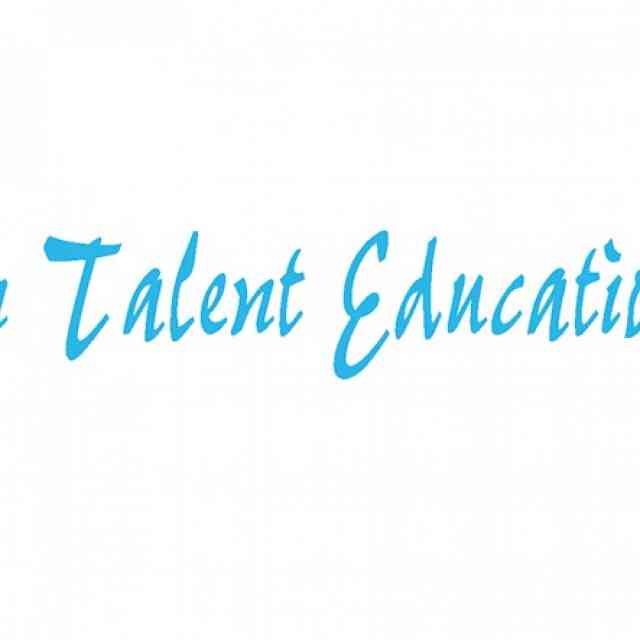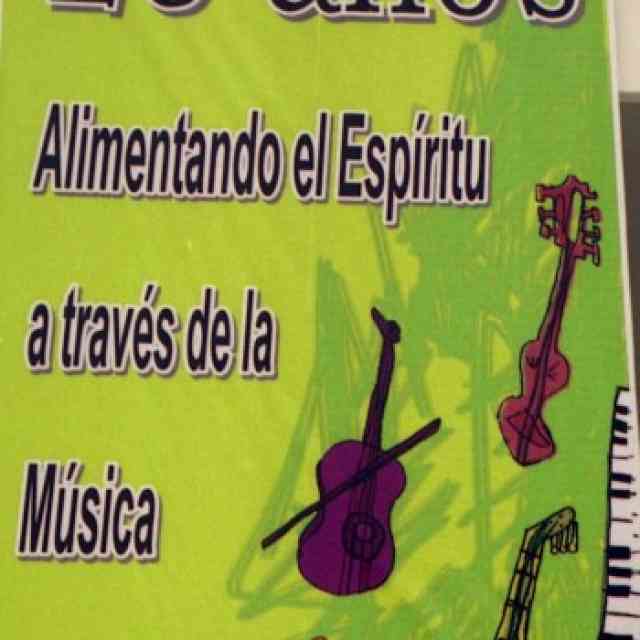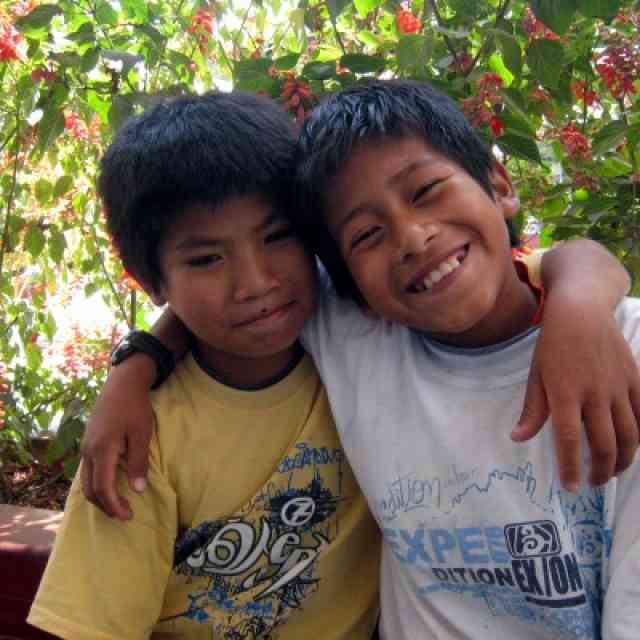On July 7, 2008 we began an exciting new event in the development of Suzuki Guitar in North America: the first International Suzuki Guitar Festival, held at the Santa Clara Convention Center in sunny California. No one knew quite what to expect. This Festival, brought together by the excellent organization and leadership of Frank Longay, director, and Kim Buller, administrator, hosted Suzuki teachers from Sweden, Australia, Spain, Mexico, Canada, Argentina, Chile, Peru, New Zealand and from every corner of the United States. There were 60 students, and 29 teachers taking training. Frank Longay taught Book 1 and ECC; MaryLou Roberts, Book 2; Mychal Gendron, Book 3; and David Madsen, Book 5. Brazilian Drumming and Guitar Styles was taught by Celso Machado, Pickin’ and Grinnin’ by Mark Marston, Chamber Ensemble by Zeah Riordan, iJAM by Michele Horner, and Jazz Improvisation by Seth Himmelhoch. The teachers involved in training sessions were treated to a great variety of teaching styles to observe, with the teaching of Harald Söderberg, and Andy LaFraniere who were teaching student masterclasses.
“Imagine spending a week watching the best Suzuki guitar teachers in the world perform their magic with young guitar students from around the world. While the teachers would not call it magic, it was magical for a Teacher Trainee like myself to see the variety of styles and tools used for guitar students to work toward the common goal of playing beautiful music. Whether the teaching style is from Australia, New Zealand, Argentina, Sweden or any region in the United States, the one-point teaching philosophy of the Suzuki Method is not magic. It’s a highly successful and proven method of enjoying the process of learning to play beautiful music. This was proven to me over and over again during my 16 hours of observing master class and group lessons. Hopefully, I can be as contagious with my enthusiasm for teaching the guitar as these fantastic teachers from all over the world were.”
–Harold Sexton, teacher trainee, California
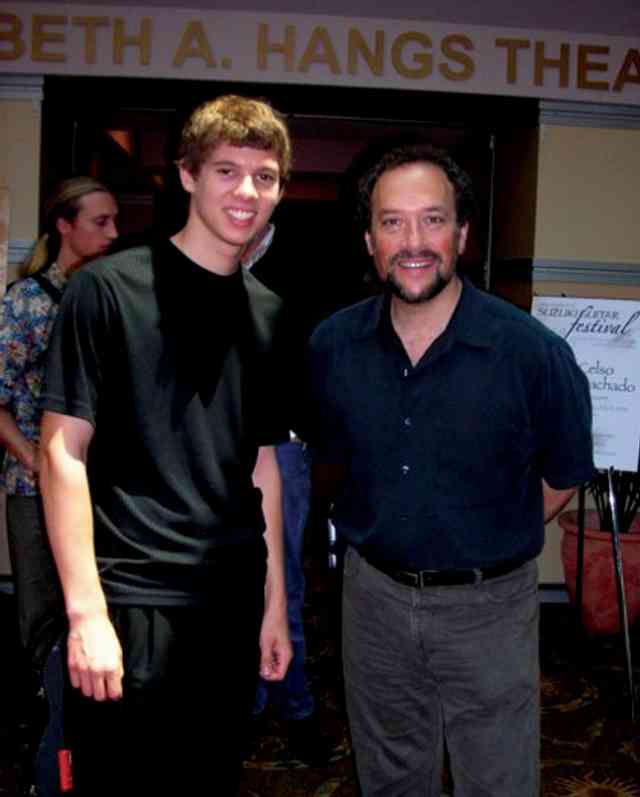
William Kanengiser with student Cory
The opening event was a Masterclass with William Kanengiser, virtuoso member of the LA Guitar Quartet. Six students were chosen by recorded audition to play. Seth Himmelhoch writes: “He seemed to really be impressed with the level of playing from the Suzuki kids and he taught them with gentleness, respect and a high artistic standard. I was taken with the way he pushed for more from the kids, while maintaining a positive demeanor.”
The students learned so much about the music, as Kanengiser naturally translated what could be complex musical phrasing into a younger language. His analogy for a good ritardando was remembering in his childhood days, putting a playing card in the spokes of a bicycle wheel, to make a clicking sound. When speeding up, it clicked faster, and when it slowed down, it was a nice, even click, cli c k, c l i c k…. It was a perfect way to relate this concept, and was easily picked up by the young student. When talking about a phrase with a pedal tone, he recommended playing it without the pedal tone, to find the notes that need more accentuation, calling them “the juicy notes.” Teaching phrase direction was easily translated into the piece. William commented afterward that all the students played really well and were very flexible and amazingly quick at incorporating different ideas. His concert that evening was inspiring and gave the whole festival a musical and technical reference that was used in many master classes and teacher training sessions during the week. His first half was music of Fernando Sor and his transcription of Mozart’s Sonata in A major, K 331, which ends with Rondo alla Turca. It was very interesting to hear a full Mozart Sonata on the guitar, imagining what it would have been like had Mozart written for the guitar himself. The second half included contemporary music of Bogdanovic, Hand, Johanson, Hedges and Head. It was a treat for the students to expand their concept of guitar music, as well as the prepared guitar sounds including paper clips!
“I was very touched by the reception at my recital, which was met with warm appreciation. I remember looking up at the audience, and being amazed at how attentive and quiet the seven- and eight-year-old students were! It gives me great hope for the future of the classical guitar to see new players and audiences being nurtured so well.”
–William Kanengiser
At the Opening Ceremony on the first evening, Frank Longay expressed his appreciation for the work of Dr. Suzuki. With the completion of the Suzuki Guitar Book 9, we have reached a new milestone in the development of the Suzuki Guitar School. This Festival was to celebrate this accomplishment. He writes: “Dr. Suzuki left for us an extraordinary legacy. He maintained and continued to demonstrate that all children may achieve an extremely high level of ability if given the proper environmental conditions. Our experience with teaching the guitar, over the past twenty years, demonstrates this. The ‘best environment’ means that we, as parents and teachers, are its most influential part….We must learn to become the best person we can be. In taking on this challenge we begin, and continue, to unveil all that is the best in the true nature of our humanity. What emerges are deeply rooted qualities such as respect, kindness and above all else love. It is extremely fortunate, for those of us that love the guitar, that over twenty years ago Dr. Suzuki welcomed our noble instrument into this process of self discovery and service to our children.”
His thoughts echoed the thoughts of many guitarists attending the festival; we are all so thankful for the work of the early pioneers, including Frank Longay, Bill Kossler, and Elio Galvanio who, over the past 20 years, have given much time and energy to the formation of a method that is reaching so many children worldwide. Frank ended his speech with an anonymous quote, “When you go to take a drink, be sure to thank the man who dug the well.” The Ceremony ended with the faculty and advanced students performing Tarrega’s magical tremolo piece, Recuerdos de Alhambra, a nimble ensemble feat, and a tribute to the beauty of our instrument, and the cooperation of many.
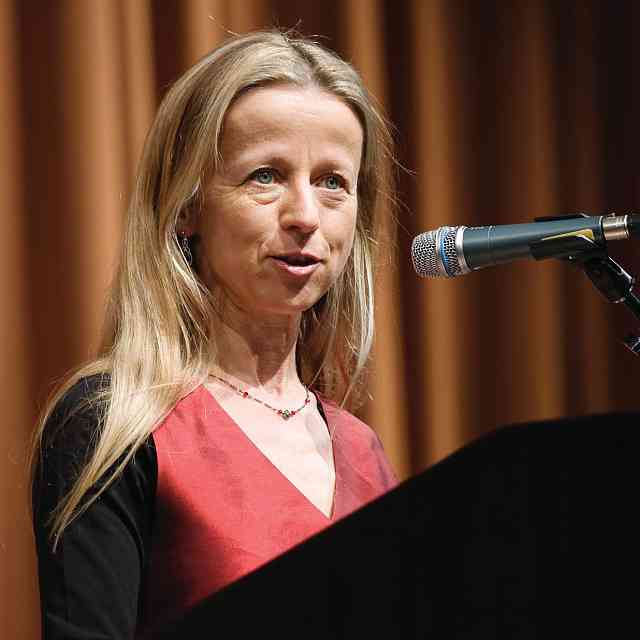
Zeah Riordan
In the Keynote speech entitled “Sympathetic Resonance – The Magic of the Suzuki Community” on the following night, Zeah Riordan from Melbourne, Australia commented:
“When we create a singing, bell tone on our guitars, the whole instrument comes alive, not just the one tone. It seems to me, that this acoustic phenomenon which is so essential to the beauty of the guitar is also a wonderful metaphor for the process that I witness in the Suzuki movement. Dr. Suzuki’s vision is like the fundamental tone to which we are all listening and resonating and responding. From his educational philosophy a worldwide community has evolved.
“I believe that Suzuki Guitar is making an undeniable impression and lasting contribution to the development of guitar pedagogy, the quality of teaching practice and the quality of players by developing a methodology that enables the youngest child to study the instrument. In resourcing the next generation of musicians and audience members through the rich educational and musical philosophy of Suzuki approach, we are indeed contributing to the cultural wealth of our society. This well-known Chinese proverb encapsulates the idea of this ’sympathetic resonance,’ our Suzuki community, and Dr. Suzuki’s hope for a better world:
‘If there is light in the soul, there will be beauty in the person.
If there is beauty in the person, there will be harmony in the house.
If there is harmony in the house, there will be order in the nation.
If there is order in the nation, there will be peace in the world.’”
“After listening to the key note address titled ‘Sympathetic Resonance – The Magic of the Suzuki Community’ given by Zeah Riordan from Australia, I realize that I have another important theme to take back home… The teaching I have done here in Little Rock and what our children have achieved in these past years is awesome and is an excellent contribution to the greater Suzuki Guitar community. Dr. Suzuki wanted families to be part of a community. He fostered cooperation, not competition. After attending the festival, I feel more confident about my own playing and teaching.”
–Lisa Ronis, teacher trainee, Arkansas
The evening was rounded out with performances by the Hartt School of Music Guitar Orchestra with David Madsen directing, and students from the Longay Conservatory of Guitar.
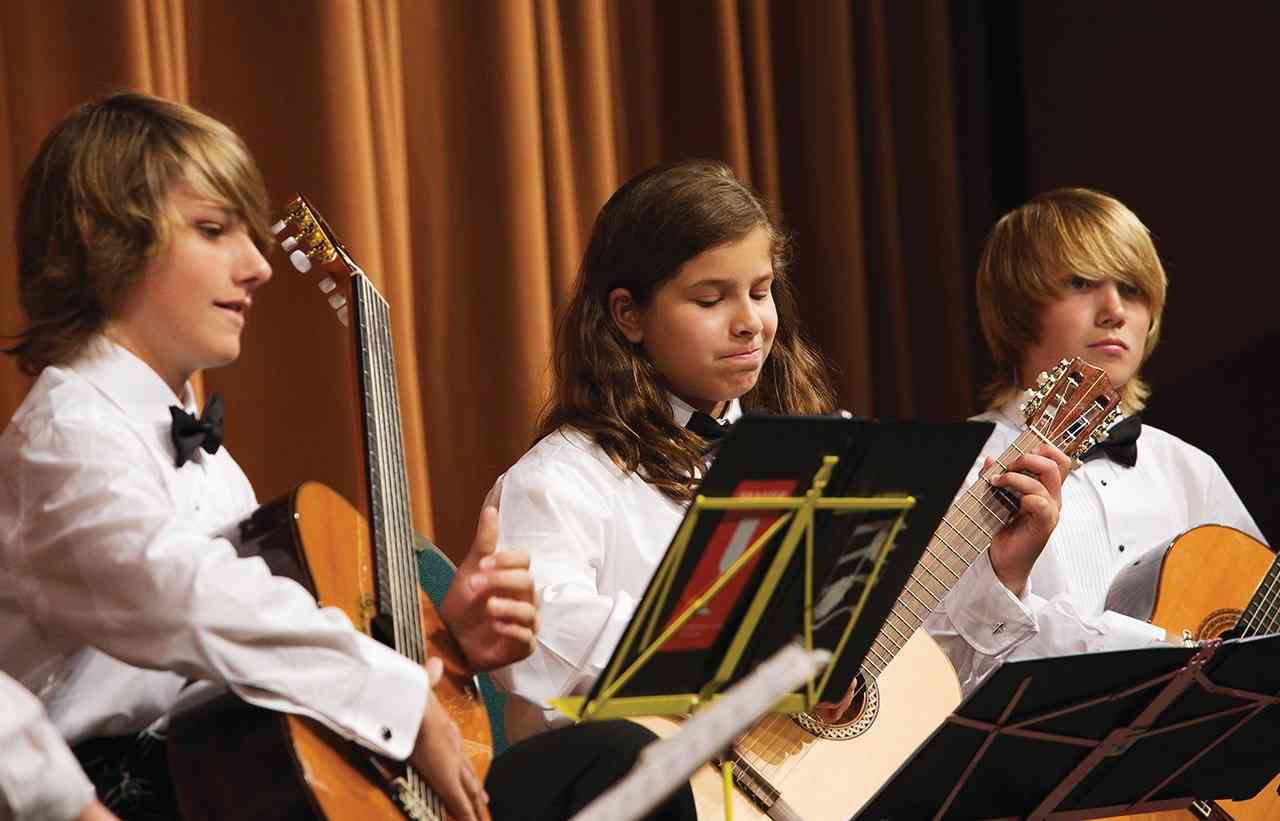
Members of the Hartt School of Music Guitar Orchestra
“I brought a group of nine Suzuki guitar students who were chosen as one of the ensembles to play in the Schools Concert, representing the Hartt School. It was a great experience for me, for the students and for the parents who accompanied the group. Playing in the Schools concert was a highlight for us, and seeing Celso Machado’s and Bill Kaningeiser’s concerts was incredibly inspirational. My students got to network with guitar students from around the world. It was great to meet up with many of the Suzuki guitar teachers and trainers that I have met over the years. The teacher workshop participants had incredibly good observation opportunities at all levels and came away from the festival with a great view of the possibilities of our method. It really was a great boost to our Suzuki Guitar community.”
–David Madsen, Connecticut
The students at the festival were inspiring to each other, and to many teachers taking training. Sasha Witten-Hannah, a teacher trainee from New Zealand, writes: “I’ve heard the emphasis on tone being described as chewing–gum strings, ice–cream scooping, contact, you name it, but the beauty arrived at was universal and full of heart. It was impressive to see the achievements of young students who had no memory of ever not being able to play the guitar, and see the great care they took to listen and learn everything that was being taught.”
“I observed a group of tiny Book I players preparing Tanz for the final concert. The music they played with their instructor was wonderfully performed and their ability to play with feeling and interpretation at their age was something that touched my heart,” says Jim McReynold, a trainee, from Oregon. The 60 or so students heard each other in masterclasses, afternoon recitals, and many fine moments at the Friday night Showcase Concert, so younger students emulated older students throughout the week and beyond.
“Really, for me this Festival was a great experience—knowing so many friendly people, delighted with the Method, and above all filled with new energy to go ahead and really think that the work we do is done with love.”
–Tatiana Munoz, trainee, Santiago, Chile
The students at the festival were frequently seen playing pieces together in the hall, and at the tables in the Mezzanine. One day, while I was sitting reading observations, an 11-year-old boy walked in and asked, “Hey, does anyone want to play something?” So we sat and played some Book 5 and 6 pieces, sharing our favorite parts, and talking about what we like to do with the music. The rapport was unique, sometimes students played poker, sometimes Vivaldi. All the while, the Brazilian guitarist and percussionist Celso Machado just might wander in between his classes, playing a chorinho, or anything else he had picked up. “It was so much fun when we all met at the table in the lobby to try out new guitars (which were beautiful instruments by Kenny Hill) and Celso improvised amazing duo parts for our standard guitar pieces like Canarios and the Valsas by Antonio Lauro. Celso had such a feel of offhand intensity in his playing which he was so open about sharing with anyone who wanted to join in.” We also played the Brazilian piece “Sounds of Bells” by Guimares from Suzuki Guitar Book 7 with Celso getting his unique Brazilian perspective and feel in our rhythm.
“I left California with many memories of friends (new and old), teaching moments, and many rhythms of classes that will forever stay in my mind to remind me of what a great week it was and a wonderful experience that could not have been any better!”
–Chas, student, North Granby, Connecticut“The level of playing was very high and the attitude of the students was a real shot in the arm. Each student in attendance was enthusiastic and brought so much talent to the table that I as a teacher had to think hard and fast to have something of value for them to take home each day. One high point in my teaching was the in the advanced group class when they played Carcassi’s Etude from Book 6 with such dynamic contrast that it raised goose bumps on the arms of this old guitar veteran!”
–Seth Himmelhoch, Teaneck, New Jersey“I spent beautiful moments teaching the students assigned to me, all of them very talented, attentive and respectful.”
–Diana Chagalj, Buenos Aires, Argentina
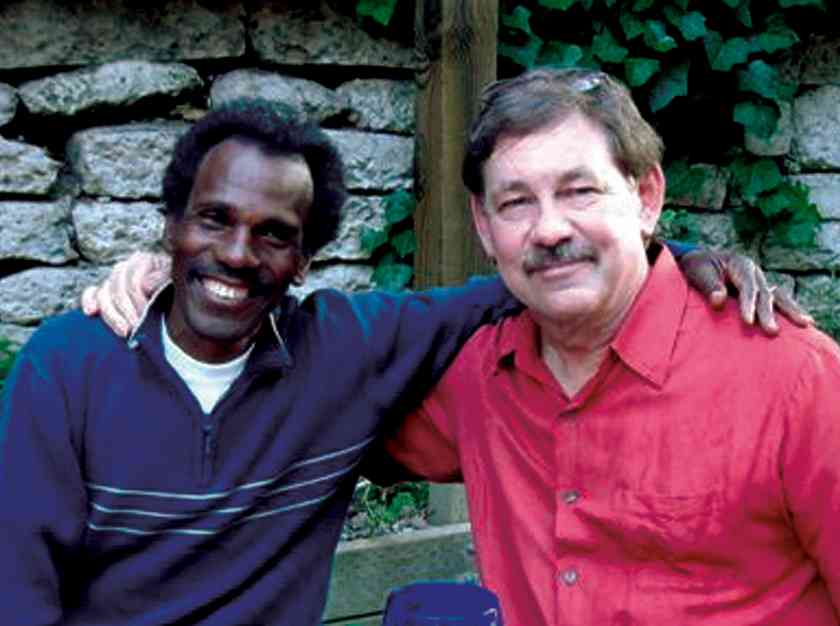
Celso Machado and Frank Longay
Besides playing and sharing music between classes, Celso Machado gave a concert mid- week which delighted everyone in the audience. His vibrant, rhythmic style kept everyone happy and amazed, whether it was playing original compositions with different tunings, or improvising a rhythmic medley, even using a water bottle, he kept the audience feeling rhythms all night long. Some pieces were guitar and vocal; some were body percussion. In one piece, he kept de-tuning the sixth string, while everyone wondered what he was doing. He finally took the entire string, and wrapped it around the other strings, creating a surprising sitar-like sound. After the concert, we all went to a Brazilian restaurant, where we tasted some authentic Brazilian food. David Madsen counted that it took only two minutes after eating before Celso was introducing himself to the band, joining in with great improvisations, energizing their music, which went on into the night. A joyous evening was had by all, everyone enjoying the moment, the friendships, and Diana Chagalj from Argentina began to dance, so everyone joined in!
“Brazilian guitarist Celso Machado continued making music in every break between classes: sharing, showing, and creating. Wow! His concert was a true highlight. My smile muscles were tired because I simply could not wipe the smile from my face ! His music making was so joyous!”
–Zeah Riordan, Australia
The daily parent discussions were a great resource in and of themselves: “Motivation: Creating the Desire to Learn” by Zeah Riordan, “The 10-Year Plan” by Mychal Gendron, “Driving with the Brakes On” by Frank Longay, and “Seven Strategies for Successful Parenting” by Zeah Riordan, and “Listening: The Key to the Suzuki Method” by Michele Horner.
On “The 10 Year Plan” Mychal Gendron writes: “I talked about the ten-year relationship my daughter Adrienne and I have had as student and teacher and what the future holds for us now that she is about to enter high school. I had documented our history with an old video of Adrienne practicing “The Wheels on the Bus” at age three, and playing duets with me now at age thirteen; in spite of my preparation, I did not want this to be my “show”, but simply the impetus for long-standing Suzuki parents to share their own experiences and insights. And share they did—we discussed the value of early beginnings, practice strategies and time management. A particularly meaningful dialog was set in motion by the topic of “knowing when to let go”—this included more independence for older students, and achieving a balance with the many demands on a teenager’s time and energy.”
Michele Horner’s presentation was clean and to the point: “Listen Like a Maniac!”
“Here’s a tip that will make the job of all Suzuki parents much easier:
Play the Suzuki CD Repeatedly for your child every day. Parents who want to jump start their child’s motivation and/or help their children progress in the easiest and smoothest way possible through the Suzuki repertoire buy into the concept of repeated daily listening to the CD. Suzuki is based on the model of language learning. Infants are surrounded at all times with their native language. Imagine if an infant only heard their native language for 15 minutes a day. That would seem ridiculous, right? Yet, many times, parents neglect playing the Suzuki CD for their child or only play the CD one time a day. YIKES! This is akin to expecting their child to speak fluently without hearing the language.
It is the parent’s job to play the CD for their child! I had a young student who was struggling to remember Lightly Row, yet could sing all the words to an entire Pearl Jam album. Guess what music was being played repeatedly at home. Guess which music wasn’t being played at home. Suzuki parents universally want the best for their children. Parents commit to bringing their kids twice weekly to lessons and to practicing with them every day, yet without the necessary component of repeated daily listening to the Suzuki CD, all of their efforts may be stalled or diminished. So, what’s the best way to listen? I call it: “Listening Like a Maniac”
-
Parents must make the commitment to play the Suzuki CD every day. If you don’t play it, they won’t hear it! I challenge all Suzuki parents to take the Listening Challenge and play the CD 100 days in a row. Kids routinely do 100-day Practice Challenges. I’m throwing down the 100-day gauntlet to parents. Try it, and see what happens!
-
Use the “magic button.” The “repeat one” function on your CD player or computer is the magic button. I used to make Magic CDs of my daughter’s current piece and the next two pieces ten times in a row each. This became hard to keep up because my daughter progressed through the pieces on those CDs so quickly that I was having trouble making CDs fast enough. Then I discovered “repeat one.” Now we listen to her current piece on “repeat one” for an hour, and then change to the next piece. Some of my students have completed two Suzuki books/year by doing this type of listening. You use repetition in practicing. Why not incorporate repetition into your listening regimen too?
The Final Gala Concert included over 90 guitarists on stage together. All levels of ensembles played together beautifully.

Final Gala Concert at the International Suzuki Guitar Festival
“My students who made the trip came back with a new idea of what they can accomplish, after seeing so many children who started just like they did. Everyone also said that the final concert was something beyond anything they could imagine, with so many guitarists playing together on one stage!”
–Mark Marston, Pennsylvania
The Ensembles were led by Zeah Riordan, Mychal Gendron, MaryLou Roberts and David Madsen. Each group had four one-hour rehearsals in which to prepare. The preparation of the students was excellent, and the pieces all came together with style. David Madsen writes: “When I first became involved in the Suzuki guitar method in the early 90s, I never dreamed of something like this festival as being possible. This was a great tribute to Frank Longay, Bill Kossler and the other pioneers and their work in developing the method for guitar. And as always, it was a great tribute to the vision of Dr. Suzuki and his philosophy, for we truly had an incredible group of teachers, parents and children celebrating his legacy.” The final play down was a gift to all attending the festival. From the very first Twinkles, to the dance-like Canarios, we all danced with our fingers to end a wonderful week.
“The Festival was a very positive experience for me. Sharing ideas and camaraderie with fellow teachers, seeing young students play at such high levels of ability, and having the Kanengiser master class/concert and Celso Machado concert were all memorable high points of the week’s program. Perhaps the high point of the off-program activities was seeing Celso light up the room when he joined in with the band at the Brazilian restaurant after his concert. Congratulations on an inspiring and well planned festival.”
–Jay Rosenberg, teacher trainee, New York“One year ago we envisioned a week of community, heart, inspiration and knowledge and with everyone’s help, our hopes were abundantly exceeded. The Suzuki guitar community is rich with many wonderful people of all ages and nationalities and it was a tremendous pleasure and honor to bring you all together during this inspiring week.”
–Frank Longay and Kim Buller
I am looking forward to the next 20 years. As we renew friendships and teaching comrades, we are building on the Legacy that has gone before us. This Festival was a giant step. Thanks to everyone throughout the world involved and supporting the development of Suzuki Guitar!

